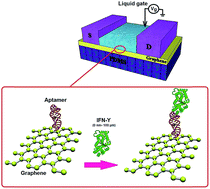ISVR modeling of an interferon gamma (IFN-γ) biosensor based on graphene
Abstract
Nowadays the detection of proteins plays a crucial role for the early diagnosis of diseases. The combination of biosensor application with nanotechnology has offered new alternatives for clinical diagnostic techniques. One of the major public health problems in many developing countries is tuberculosis (TB) susceptibility and Interferon-gamma (IFN-γ) can be used in the diagnosis of this infectious disease. In this study, a prototype graphene based FET structure was employed as a biosensor. Additionally, a PDMS layer was deployed beneath the graphene as a dielectric layer. As a result of the changeability of Ids (drain–source current), the carrier concentration would change when the IFN-γ molecules attach to the surface of graphene. To acquire another pattern for the I–V (current–voltage characteristic), the Incremental Support Vector Regression (ISVR) algorithm was also employed. The comparative study based on the outcomes of the ISVR and pre-existing analytical models with experimental data found that there was acceptable agreement, which was able to substantiate the proposed models. Moreover, the ISVR showed that the proposed method remarkably improved the accuracy of prediction.


 Please wait while we load your content...
Please wait while we load your content...